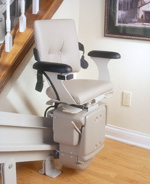Improving the Staircase Safety of Seniors and Others with a Stairlift
Published by Stephen on September 14, 2009 Under stair lifts Due to advancements in medical technology and care, the average life expectancy is steadily increasing. When compared to that of only a hundred years ago, people are living longer and more healthy lives. This can and is a wonderful thing, as age often brings wisdom and a much greater understanding of the importance of life. However, there are also some medical conditions that become more likely with age and can limit a seniors mobility. One of the most common limitations that occurs is the ability to safely use the staircase, which presents some very serious safety risks.
Due to advancements in medical technology and care, the average life expectancy is steadily increasing. When compared to that of only a hundred years ago, people are living longer and more healthy lives. This can and is a wonderful thing, as age often brings wisdom and a much greater understanding of the importance of life. However, there are also some medical conditions that become more likely with age and can limit a seniors mobility. One of the most common limitations that occurs is the ability to safely use the staircase, which presents some very serious safety risks.
The staircase can be dangerous to people of all ages, but seniors are most likely to receive a serious fall on the staircase that results in hospitalization. This can be caused by a number of conditions, such as arthritis, which can cause joint discomfort making bending the knees painful, or glaucoma, which can make it difficult to see where each step starts and ends. In many cases, it is the combination of these kinds of medical conditions that make using the stairs safely next to impossible.
In these kinds of situations, it is very important to find a means of making the stairs easy to use and decreasing the risk of a fall. It is simply not practical or safe to rely on someone to help use the staircase and avoiding the stairs is also rarely practical. Instead, using a stair lift is one of the best ways to allow full access to a home with a staircase, without breaking the bank.
Stair lifts are not exactly a new invention and were first developed during the 1920′s. However, it would be over 60 years before these devices became commonplace and affordable enough to be used in residential settings. Today, stair lifts are more common than ever and typically use the stair chair design.
The stair chair design sends a chair up and down the staircase on a metal track-way. The metal track, which is actually attached to the steps of the staircase, is designed out of a very strong and lightweight material. The advantage of this design is that it can be used on most staircases without any actual major home renovation, aside from screwing the track to the staircase.
The stair chair design is also much safer than other types of stair lifts, because the individual will remain seated as they move up or down the staircase. This differs from standing stair lifts, called perch lifts, that move the senior up the staircase as they are standing.
Most stair lifts that share this design can be installed by the homeowner and so in addition to not having a high upfront cost, it is also possible to save money when it comes time to install the stair lift.
For stairways that are very narrow or curved, it is also possible to get stairlifts that are secured to the wall instead of the staircase. These will typically be considerably more expensive than traditional stairlifts and also have a much more complicated installation process, so will require a professional stairlift installer.
No Comments |
Add a Comment